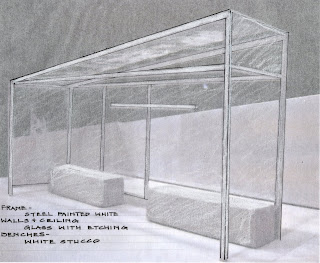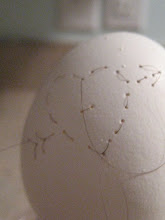





I have designed a bus shelter for a site on A&T University's campus at St. John's Lodge on E. Market Street. My concept is to integrate the shelter into its environment through the use of forms and materials in the visual language of the surrounding buildings, visual lightness that expresses respect to the surroundings and makes the shelter literally blend in with and reflect its environment, and sandblasted images of the view of downtown Greensboro from the bus stop. The angle of the roof, rectangular forms, and use of white stucco in the benches tie the shelter to its immediate surroundings while the etched images set the shelter in the context of the city and community as a whole.
There is a strong presence of elongated rectangles in the windows of St. John's Lodge building behind the bus shelter site as well as the building to the left of St. John's Lodge. As you look across the street, there is a repetition of these clean, modern, rectangular forms in the buildings there as well. A brick and iron ramp leading to the entrance of St. John's Lodge creates a very dominant angular form directly behind the site. My design echos this angle in its roof line. Elongated rectangles are present in backless benches against the back wall of the shelter, the area for posting information, and the rectangular sandblasted images of the view of downtown through the side wall and the image of tree branch shadows on the roof of the bus stop. The image of the city frames a view and emphasizes the city as whole in the present. In the future it will be a record of the past. The tree branch shadows in the roof provide unexpected beauty in the often unremarkable experience of waiting for a bus. Shadows will be cast onto the benches and sidewalk and will move and appear/disappear throughout the day. The shelter is constructed of a thin white metal frame and glass panels that make up the walls so that it is visually very light and blends with the environment rather than competing with the building and ramp behind it. The ramp is dedicated to P.M. Clarence Garris through a plaque located on one of its brick areas. The largely transparent shelter structure respects the ramp and monument by insuring that they remain visible through the use of glass walls and by moving to the left of the current bus stop location. The shelter is wheelchair accessible providing well covered space between the two benches. The information bar located on the back all of the bus consists of one thin white metal bar that has plexi glass sign/map holders attached to it. If there is no sign in a holder, it virtually disappears. The two benches are in white stucco to create a tie to the stucco in surrounding buildings.
I have created a bus shelter that functions to protect bus riders from the elements as they wait for a bus, becomes part of its surroundings while respecting those surroundings, provides information, and provides a moment of beauty in a situation that can be mundane.










A&T bus shelter site









No comments:
Post a Comment